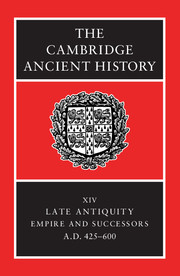Book contents
- Frontmatter
- PART I CHRONOLOGICAL OVERVIEW
- 1 The western empire, 425–76
- 2 The eastern empire: Theodosius to Anastasius
- 3 Justin I and Justinian
- 4 The successors of Justinian
- 5 The western kingdoms
- PART II GOVERNMENT AND INSTITUTIONS
- PART III EAST AND WEST: ECONOMY AND SOCIETY
- PART IV THE PROVINCES AND THE NON-ROMAN WORLD
- PART V RELIGION AND CULTURE
- Conclusion
- Chronological Table
- BIBLIOGRAPHY
- Index
- References
4 - The successors of Justinian
from PART I - CHRONOLOGICAL OVERVIEW
Published online by Cambridge University Press: 28 March 2008
- Frontmatter
- PART I CHRONOLOGICAL OVERVIEW
- 1 The western empire, 425–76
- 2 The eastern empire: Theodosius to Anastasius
- 3 Justin I and Justinian
- 4 The successors of Justinian
- 5 The western kingdoms
- PART II GOVERNMENT AND INSTITUTIONS
- PART III EAST AND WEST: ECONOMY AND SOCIETY
- PART IV THE PROVINCES AND THE NON-ROMAN WORLD
- PART V RELIGION AND CULTURE
- Conclusion
- Chronological Table
- BIBLIOGRAPHY
- Index
- References
Summary
JUSTIN II
Imperial succession
Despite his age and the conspiracies of his latter years, Justinian took no steps to designate a successor. Whether he could not decide between the merits of various relatives, or stubbornly preferred to allow the traditional constituencies of senate, army and people to select a suitable candidate, is unknown, but as a result the succession was presented to the man on the spot, his nephew Justin, son of his sister Vigilantia and husband of Sophia, the ambitious and competent niece of Theodora. Since at least the early 550s Justin had been curopalatus, a position of modest significance but central to palace life, and had shown resolution in quelling faction rioting in 562, but his career does not appear as distinguished as that of his main rival within the extended imperial family, his cousin Justin, son of Germanus, who had won victories in the Balkans and was currently serving as magister militum on the Danube. Justin the curopalatus, however, was in Constantinople and was well supported: the comes excubitorum, Tiberius, was a protégé, and his presence in command of the imperial bodyguard indicates that Justin had been planning ahead; other supporters included the quaestor Anastasius, and the newly-appointed patriarch of Constantinople, John Scholasticus, who had transmitted the prediction of Justin’s succession made by Symeon Stylites at Antioch, and who now performed the coronation; Callinicus, a leading senator, invited Justin to accept the succession, while his brother Marcellus and son-in-law Baduarius were both patricians.
- Type
- Chapter
- Information
- The Cambridge Ancient History , pp. 86 - 111Publisher: Cambridge University PressPrint publication year: 2001
References
- 2
- Cited by

